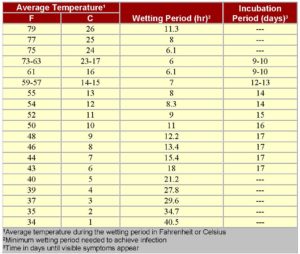The recent spate of cool, wet weather has left one organism happy, Venturia inaequalis, the fungus that causes apple scab. Most of the state just underwent an extreme scab period, and unfortunately, few of us could do anything about it because of the combination of rain and wind. The revised Mill’s table (from http://www.fruit.cornell.edu/tfabp/revmills.htm )identifies this period as taking anywhere from 8 up to 30 hours.
Unfortunately, days of rain provide the perfect infection period. The kicker is the fact that infection develops really slowly under these cool, wet conditions. This means symptoms may not show up for another two to three weeks. At this point, everyone is thinking ‘Fungicide resistance!’, as opposed to what really happened—heavy rains that washed off any trace of fungicide, plus a long, cool wet infection period that delayed symptom development.
Obviously, we are past the point of rescue sprays. Furthermore, for those of you with the heaviest rains, you may have needed a canoe, kayak or small boat to get into the orchard. Heavy winds might (or should) have prevented spraying, too. So, what is a grower to do?
Keeping fruit protected is the key. Heavy rains will work against powdery mildew, but drive apple scab. The summer rots (bitter, black, white) require warm, wet conditions according to the literature. In my experience, fungi are not very good at reading the literature. Alternating between the DMI fungicides (FRAC 3; Inspire, Indar, Topguard, and Rally if you don’t have significant resistance) and strobilurins (FRAC 11; Flint, Sovran) or FRAC 11+7 pre-mixes like Pristine, Merivon, and Luna Sensation; these fungicides will control scab, powdery mildew, rust and some summer rots. For those varieties still under the 77-day PHI, I cannot stress the use of mancozeb enough to provide a tank mix partner (where needed), as it provides good scab control plus excellent summer rot protection. Plus, in this period of crazy tank mixes (petal fall to 2nd cover), minimizing captan use (and risk) is always a good thing.
There’s not much we can do about the weather. “May and June. Soft syllables, gentle names for the two best months in the garden year: cool, misty mornings gently burned away with a warming spring sun, followed by breezy afternoons and chilly nights. The discussion of philosophy is over; it’s time for work to begin.” –Peter Loewer
